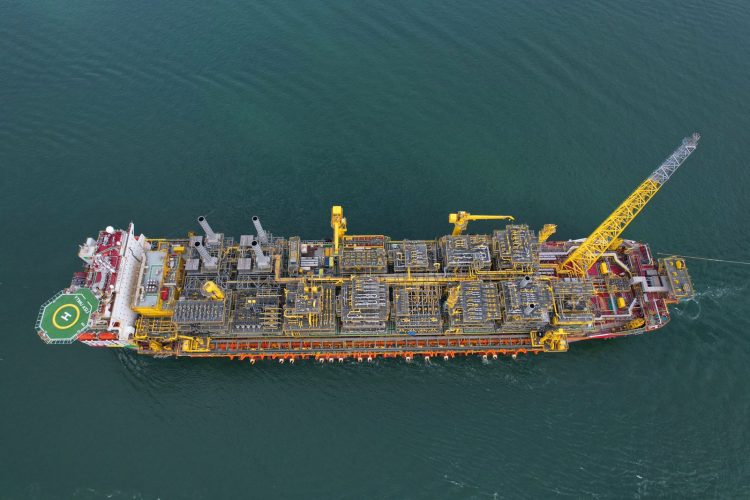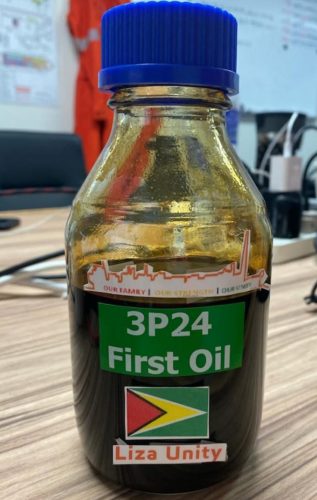ExxonMobil’s second platform in the offshore Stabroek Block yesterday began producing oil with the expectation of reaching full capacity of 220,000 barrels per day by the end of the year and intense scrutiny of its gas flaring.
The startup of the second Floating Production, Storage and Offloading (FPSO) vessel – the Liza Unity – comes earlier than expected as Minister of Natural Resources Vickram Bharrat had indicated that it would have begun later this month.
“Production at the Liza Unity …. vessel is expected to reach its target of 220,000 barrels of oil later this year, as operations continue to be brought safely online,” the company said in a statement on Friday.

“It adds to the more than 120,000 barrels per day of capacity at the Liza Destiny FPSO, which began production in December 2019 and is now delivering at better than design capacity, it added, while noting that the Stabroek Block’s recoverable resource base is currently estimated at more than 10 billion oil-equivalent barrels.
“We are collaborating closely with the government and people of Guyana to develop this world-class resource responsibly, helping to meet the world’s energy needs and delivering enhanced value for all stakeholders at a record pace and well ahead of the industry average,” Liam Mallon, president, ExxonMobil Upstream Oil and Gas, was quoted as saying. “With unparalleled project execution, we now have two production facilities operating offshore Guyana.”
The Liza Destiny, which has been producing oil since December 2019, has been plagued by technical problems with its flash gas compressor system, leading to millions of cubic feet of climate-endangering gas being pumped into the atmosphere on a daily basis. These problems have not yet been resolved.
ExxonMobil yesterday reassured that better gas compression technology will be available on the Liza Unity.
Gas compressor challenges
Production Manager Mike Ryan, in a video statement, said at the moment the focus is on commissioning the Unity’s compression train, while acknowledging to the “challenges” with the flash gas compressor system on the Liza Destiny FPSO.
“I am very disappointed about that. The team continues to work extremely hard to resolve that issue and try to minimise flare as best we can within that design,” he said, before noting that the Liza Unity uses a different design altogether.
On the Liza Destiny, he explained, there was “screw-type” design, manufactured by Man Energy for second and third stage, while on the Liza Unity there is a centrifugal system manufactured for second and third stage by Baker Hughes. “So it’s a different machine. It’s been fully tested. We have all the experts available during the startup process. We will step back if we have anything we are not happy with,” he said.
Ryan noted that the Unity’s compressors and the injection system have not seen hydrocarbon gas yet. “We have fully tested them as much as we can but they have not seen the full reservoir pressure in the gas,” he noted, while reminding that flaring for a period of time is standard in the regular startup of an offshore facility while the gas compression train is commissioned. “…We are introducing what I would say is the minimum amount of hydrocarbons, so oil and gas, to the system, to use that gas to test and fully commission the compressors and injection system… to get us to pilot level flaring,” he said
He said the lessons from Liza Destiny have been fully ingrained in their processes and these have been applied into design, testing and as the gas compression system is being prepared. “So each and every step we have been very deliberate on how we assure we are ready and how we minimise any impact on the environment.”

Best practices
The Irfaan Ali-led government welcomed the operationalisation of Liza Unity FPSO, which natural Resources Minister Vickram Bharrat said would further enhance earnings from the sector to drive Guyana’s infrastructure development and improve the delivery of services to all citizens.
In a statement, the government reported Bharrat as saying that the increased total daily capacity of oil augurs well for Guyana, especially on the heels of operationalizing the Local Content Secretariat and the Natural Resources Fund, in keeping with the Santiago Principles of transparency and accountability within the petroleum sector.
“Further, the [Government of Guyana] will be taking all necessary steps to ensure that all Guyanese benefit from the earnings derived from the petroleum sector. As such, the Government of Guyana has mandated the Ministry of Natural Resources to coordinate and work closely with international partners, local regulatory agencies, and key stakeholders within the petroleum sector to ensure the sector performs optimally in keeping with internationally recognized best practices,” it added.
The statement further stated that the Ministry of Natural Resources has committed to continue working with ExxonMobil “which will bring at least four FPSOs into operation to produce more than 800,000 barrels per day from the Stabroek Block by the end of 2025. Additionally, Payara, the third project in the Stabroek Block, is expected to produce approximately 220,000 barrels of oil per day using the Prosperity FPSO vessel, which is currently under construction.”
Government also said that the field development plan and application for environmental authorization for the Yellowtail project, the fourth project in the block, have been submitted for review by the government and other regulatory approval.
The company said that the current resource has the potential to support up to 10 projects.
ExxonMobil said it believes that timely development of these additional projects and continued exploration success offshore will enable “the steady advancement of Guyanese capabilities and enhanced economic growth.”
The company said that more than 3,500 Guyanese are now supporting ExxonMobil’s activities in Guyana. ExxonMobil and its direct contractors spent approximately $219 million with more than 880 local suppliers in 2021, a 37% year-over-year increase.
The Liza Unity arrived in Guyana in October 2021. It is moored in water depth of about 1,650 meters and will be able to store around 2 million barrels of crude.
In the Stabroek Block, ExxonMobil affiliate Esso Exploration and Production Guyana Limited is operator and holds 45% interest. Hess Guyana Exploration Ltd. holds 30% interest and CNOOC Petroleum Guyana Limited holds 25% interest.





